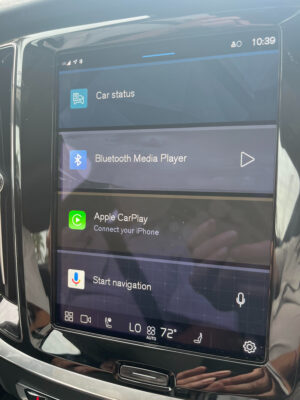Sign up for daily news updates from CleanTechnica on email. Or follow us on Google News!
The news is filled with stories about everyday vehicle buyers who don’t want to own an electric vehicle (EV). If you are really a skeptic (and I believe that the majority of anti-EV stories are AI-generated by algorithms and serve the interest of fossil fuel companies), then I have a challenge for you: make it a point to test drive a Tesla.
The difference between driving a Tesla and driving an internal combustion engine (ICE) vehicle is eye opening and amazing. Tesla, by far, exceeds comparable premium ICE vehicles on most comparative benchmarks due to its inherent differences in drivetrain and technological advances.
Side-by-side, Tesla wins, hands down.
My bet is you’ll be reluctant to return to an ICE vehicle once you’ve experienced the enhanced driving behind the wheel of a Tesla.
For its next phase of growth, Tesla is hoping people like me are right, as the company has to win over everyday buyers, who primarily select vehicles based on price and ease of use. “When you look at car buying in general, we’re trying get to the next set of EV adopters,” chief financial officer Vaibhav Taneja said during an investor call in October.
My Reverse Tesla Test Drive
I was driving our Model Y at posted speed limits through a right hand parking lot lane. A BMW pulled out of a left hand parking space and directly toward me. As much as I tried to veer right to avoid the vehicle (“Stop!” “Stop!) , a grassy berm prevented me from moving very far out of the way. The BMW dented my driver’s side front quarter panel, and now Y-Ley (sorta like the coyote) is in the repair shop.
I was sent to Enterprise by the other driver’s insurance company, and I attempted to make prior arrangements to rent an EV. No luck. EVs were rare for Enterprise, the polite customer service rep shared, and hard to locate. With a choice of a vehicle of similar class to the Model Y, I chose a black Volvo S60. It looked sleek, and I had always heard drivers rave about their Volvos. I received a tutorial on the car, and off I drove. I followed my husband in the white Model Y to the repair facility.
I was immediately taken back by how much I had to engage the brake pedal on busy US 1. Without regenerative braking, where the EV slows when the driver removes their foot from the accelerator, I was a bit of a bucking bronco, gliding forward with foot off the pedal, lunging when braking. Meanwhile, the Tesla in front of me methodically slowed and smoothly increased speed as lights changed and traffic moved in and out of our lanes.
And the noise of the Volvo’s gears shifting! Oh, my. As the automatic transmission slipped down through gears and back up with braking and acceleration, I realized how inefficient the movement is. It impacted my driving experience in a way to which I was no longer accustomed. The Model Y accelerates fluidly and at a rapid pace, should I need it, without forcing me to move in the driver’s seat.

Onto the Volvo’s dash, which is filled with unnecessary gauges, like a tachometer. I don’t need a tachometer. I need each to see navigation and helpful hints about the roads around me to make good driving decisions. A series of rows on the Volvo’s touchscreen seems more marketing than matter-of-fact, more flashy than functional. By the time I clicked through the various categories — car status, Bluetooth media player, Apply car play, or start navigation — I would likely miss a key traffic situation. I haven’t touched them since I took possession of the car.
So many people complain about the touchscreen on the Tesla, but have you ever really used one? The Model Y’s dash is quite minimalist, and, honestly, I use voice commands by pushing the wheel on the right side of the steering wheel. “Reduce temperature to 72.” Simple, elegant, and efficient. When I need to do a bit of profile reprogramming, I make it a point to do so from the quiet of my garage before heading out on the road.
Persuading Vehicle Buyers to Choose an EV
There are lots of additional reasons for vehicle buyers to look at EVs. I acknowledge that persuading the vast majority of 111 million US households who own one or more light duty ICE vehicles to switch to EVs is quite a tall task. Arguments against EVs continue but are not insurmountable.
About 40% of people in a 2023 US survey say they will switch their ICE-powered cars for an EV in the future. What will it take for them to take the EV plunge?
New vehicle buyers are looking at an expenditure that equals nearly 100% of their annual incomes; it’s the next biggest cost consideration after purchasing a house. The price of many EVs compared to ICE-powered cars and trucks is reported to be a major deterrent among potential buyers.
Combine that pricing with a plunge into unfamiliar technology, and buying an EV is no small decision. I get it.
Yes, on January 1, some of Tesla’s models lost the full $7,500 federal EV tax credit due to stricter battery-component sourcing rules from China. The company’s website says the new Model 3 Performance qualifies for a $7,500 federal tax credit for eligible buyers. But maybe Tesla is not your thing, so there are many really other nice EV models that are wise for vehicle buyers to consider. (For example, I own a used 2017 Chevy Bolt for my summer cabin in the woods.)
Moreover, driving an EV significantly reduces a person’s transportation carbon footprint, which can generally translate into a 50-70% on average reduction if a driver switches from a ICE-powered vehicle. Drivers can further curb their emissions by charging their EVs with electricity generated by renewable sources.
Pundits hold forth over how much range is the right amount of range for personal vehicle buyers. “Am I going to be paying more for a compromised version of mobility?” Alexander Edwards, president of Strategic Vision, explained in dramatic fashion to IEEE Spectrum. More models are coming to market, battery technology has advanced significantly over the last few years, and greater access to charging stations now alleviates much range anxiety. The cost of charging an EV is much less that filling up an ICE vehicle. Lower lifetime EV ownership costs, which include the cost of the purchase or lease, energy/fuel costs, and maintenance costs is another leading motivator for choosing an EV.
ICE vehicles have a tremendous impact on the environment when gasoline or other fossil fuels are burned to power vehicles. They release carbon dioxide, a potent greenhouse gas that continues to influence the climate crisis. EVs are zero emission. Case closed. Making the switch to EVs is the right thing to do. Choosing a Tesla makes the transition especially nice.
Have a tip for CleanTechnica? Want to advertise? Want to suggest a guest for our CleanTech Talk podcast? Contact us here.
Our Latest EVObsession Video
I don’t like paywalls. You don’t like paywalls. Who likes paywalls? Here at CleanTechnica, we implemented a limited paywall for a while, but it always felt wrong — and it was always tough to decide what we should put behind there. In theory, your most exclusive and best content goes behind a paywall. But then fewer people read it!! So, we’ve decided to completely nix paywalls here at CleanTechnica. But…
Thank you!
CleanTechnica uses affiliate links. See our policy here.




